|
|
|
Sort Order |
|
|
|
Items / Page
|
|
|
|
|
|
|
| Srl | Item |
| 1 |
ID:
080836
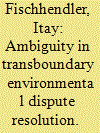

|
|
|
|
|
| Publication |
2008.
|
| Summary/Abstract |
Cooperation over transboundary environmental resources, water in particular, has been analyzed from various perspectives. Each study identifies the problems of cooperation differently and suggests different mechanisms to enhance it. Yet, the role of ambiguity, particularly significant in treaty design to resolve environmental disputes, has thus far been overlooked. Such a focus is warranted, since many international agreements regulating the use of natural resources are ambiguous in their schedule of resource delivery during crisis events or in their cost-sharing arrangements and may even include contradictory resource-allocation principles while remaining vague on how to settle the contradictions. This study aims to examine why, when, and how ambiguity is applied in agreements pertaining to natural resources, and water in particular. The Israeli-Jordanian peace agreement, which includes an annex on water-use regulation, is used as a case study. It was found that, under asymmetric power relations, when both sovereignty costs and uncertainty are high, several types of deliberate ambiguity were intentionally incorporated into the treaty. Some ambiguities allowed each side to present the treaty differently at home, thereby defusing domestic opposition, while others provided leeway to adjust the resource allocation during a future crisis without the need to renegotiate the treaty
|
|
|
|
|
|
|
|
|
|
|
|
|
|
|
|
| 2 |
ID:
082100
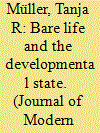

|
|
|
|
|
| Publication |
2008.
|
| Summary/Abstract |
this article Eritrea is discussed as a developmental state based on biopolitics. Taking the example of higher education, it is shown how the biopolitical project as applied to education policies and human resource development at first succeeded in terms of reinforcing personal nationalism, while at the same time opening up spaces for the fulfilment of personal aspirations. Of late, however, the biopolitical project has turned 'pernicious' and has become a tool of oppression. These developments, if they are to continue, will not only jeopardise the state's developmental agenda but may lead to the Eritrean polity in its present form becoming unviable
|
|
|
|
|
|
|
|
|
|
|
|
|
|
|
|
| 3 |
ID:
080833


|
|
|
|
|
| Publication |
2008.
|
| Summary/Abstract |
Looking beyond the democratic/Kantian peace argument that highlights the pacifying effect of regime type on international conflict, this study explores additional, potentially important domestic factors that may influence conflict - most notably, civil-military structure, such as degree of civil versus military control and military manpower system. It also looks into the effects of political communication in terms of diplomatic channels and open media. On the basis of logistic regression analysis for 120 countries during the period from 1950 to 1992, the authors report that strong military influence is more likely to lead to the onset of militarized interstate disputes, wars, and international crises while the presence of conscripted soldiers, diplomatic activities, and open media makes that less likely. These results hold up in the presence of the three Kantian peace variables (i.e. democracy, economic interdependence, and joint membership in international organizations) and other control variables that are standards within contemporary research designs. Thus, the authors conclude that the four factors are important complements to understanding the impact of domestic traits on interstate conflict beyond the conventional regime-type explanation of the democratic/Kantian peace
|
|
|
|
|
|
|
|
|
|
|
|
|
|
|
|
| 4 |
ID:
080832


|
|
|
|
|
| Publication |
2008.
|
| Summary/Abstract |
Can the world be made more peaceful through commerce? Empirical studies of the impact of trade on military conflict have yielded conflicting results depending on the specific measures and empirical domains that scholars select for their studies. The article suggests that these varying results may be due to inadequate specification of the conditions under which trade will prevent conflict. In particular, previous research suggests that democratic leaders rely on public policy successes, such as economic growth, to maintain their political viability to a greater degree than do autocratic leaders. Since trade can help promote growth, the authors argue that democratic leaders should be more averse than autocratic leaders to initiating military conflicts with trading partners, for such conflicts might damage commercial ties and hamper politically important economic growth. The authors find support for this expectation in their analysis of trade integration and international conflict initiation by democratic and autocratic states between 1950 and 1992. The results are robust across different data sources on trade and conflict, suggesting that the conditional impact of trade on conflict may explain the variance in previous results. However, these results have sobering implications for the view that trade dependence by itself can be a mechanism for preventing autocratic states from using military force
|
|
|
|
|
|
|
|
|
|
|
|
|
|
|
|
| 5 |
ID:
082098
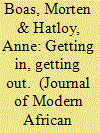

|
|
|
|
|
| Publication |
2008.
|
| Summary/Abstract |
Liberian ex-combatants are generally seen as uprooted urban youths with a history of unemployment, underemployment and idleness. The data that form the basis of this article suggest another picture. What caused the Liberian youth to fight were mainly security concerns, suggesting that the effects of 'idleness' and 'unemployment' are overstated with regards to people joining armed groups. They went to school, worked and lived with parents or close relatives prior to the war. They are not Mkandawire's (2002) uprooted urban youths or Abdullah's (1998) 'lumpens'. They lived quite ordinary Liberian lives, and based their decision on whether to join an armed group on the security predicament that they believed that they and their families were facing. This suggest that disarmament, demobilisation, reintegration and rehabilitation approaches are in need of re-thinking that links them more directly to social cohesion and societal security.
|
|
|
|
|
|
|
|
|
|
|
|
|
|
|
|
| 6 |
ID:
082099


|
|
|
|
|
| Publication |
2008.
|
| Summary/Abstract |
During the last years the DRC has made itself known in the world for terrible acts of violence committed by armed men - militia and the regular army - against the civilian population. The voices of the soldiers and combatants have so far been absent in the accounts of this violence. This silence is problematic, both because it makes it harder to understand such violence, but also because it reinforces stereotypes of African warriors as primitive and anarchic, driven by innate violence and tribal hatred. Enquiry into the particular discursive as well as material circumstances of the armed conflict in the DRC, which might better redress the complex and interrelated context in which 'people in uniforms' commit violence, is consequently impeded. The story we recount here emerges from soldiers within the main perpetrator of violence in the DRC today: the Integrated Armed Forces. The soldiers' interview texts challenge the dominant representation of soldiers and combatants in the DRC. The soldiers made sense of the prevalence of violence (in which they too had participated) in several interrelated ways, none of which reflected any expression of 'natural' (if dormant) violent tendencies, hatred or vengefulness for the enemy.
|
|
|
|
|
|
|
|
|
|
|
|
|
|
|
|
| 7 |
ID:
080835
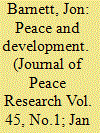

|
|
|
|
|
| Publication |
2008.
|
| Summary/Abstract |
This article develops a theory of peace as freedom that explains some important relationships between peace and development. It does this by critically examining and then synthesizing Johan Galtung's theory of peace as the absence of violence and Amartya Sen's theory of development as freedom. Galtung's theory of peace is clear on the meaning and causes of direct violence, but vague on the details of structural violence. Sen's theory helps overcome many of the problems associated with structural violence, although its focus on agents and the state tends to downplay the importance of larger-scale political and economic processes. In the theory of peace as freedom, peace is defined as, and in praxis is enlarged through, the equitable distribution of economic opportunities, political freedoms, social opportunities, transparency guarantees, protective security and freedom from direct violence. The institutions required for peace as freedom are considered, and it is suggested that the pluralist state is the best model for providing and maintaining peace as freedom. Some implications of this theory for existing and future analyses of the causes of violent conflict are discussed
|
|
|
|
|
|
|
|
|
|
|
|
|
|
|
|
| 8 |
ID:
082097
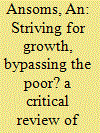

|
|
|
|
|
| Publication |
2008.
|
| Summary/Abstract |
This paper studies the Rwandan case to address some of the challenges and pitfalls in defining pro-poor strategies. The paper first looks at the danger of a purely growth-led development focus (as in Rwanda's first PRSP), and evaluates the extent to which the agricultural sector has been a pro-poor growth engine. It then studies Rwanda's current rural policies, which aim to modernise and 'professionalise' the rural sector. There is a high risk that these rural policy measures will be at the expense of the large mass of small-scale peasants. This paper stresses that the real challenge to transform the rural sector into a true pro-poor growth engine will be to value and incorporate the capacity and potential of small-scale 'non-professional' peasants into the core strategies for rural development. The lessons drawn from the Rwandan case should inspire policy makers and international donors worldwide to shift their focus away from a purely output-led logic towards distribution-oriented rural development policies. In other words, the challenge is to reconcile efficiency in creating economic growth with equity, and perhaps, to put equity first.
|
|
|
|
|
|
|
|
|
|
|
|
|
|
|
|
| 9 |
ID:
080831
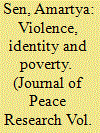

|
|
|
|
|
| Publication |
2008.
|
| Summary/Abstract |
The article discusses two main approaches to explaining violence in contemporary global society. Theories based on the culture of societies, among which the theory of the clash of civilizations is the most influential, attempt to explain violence by referring to antagonisms between collective identities. Theories of the political economy of power and inequality seek the sole cause of violence in economic factors. While each approach has some plausibility, both are inadequate on their own. When applied as sufficient explanations, they may distort our understanding in a way that undermines the possibility for both alleviating poverty and reducing conflict. The causal mechanisms are more complex than economic reductionism is capable of accounting for. Poverty and inequality are importantly linked to violence, but must be seen together with divisions between factors such as nationality, culture and religion. In turn, these factors must not be based on a false image of solitary identities and unavoidable antagonisms between cultural groups. The article suggests that the coupling between cultural identities and poverty increases the significance of inequality and may contribute to violence. Approaches to explaining violence should avoid isolationist programmes that explain violence solely in terms of social inequality and deprivation or in terms of identity and cultural factors.
|
|
|
|
|
|
|
|
|
|
|
|
|
|
|
|
|
|
|
|
|